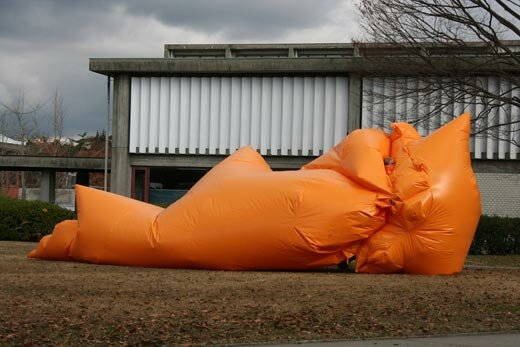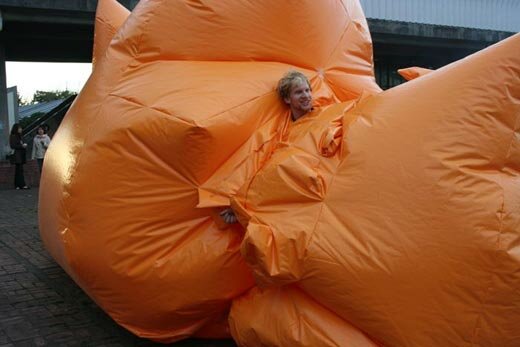January 2008
Monthly Archive
Monthly Archive
Posted by ben on 31 Jan 2008 | Tagged as: adventure day, art paparazzi, arts organizations, celebrity sightings, interviews, outsider
A little while back we did a series of posts on publicly accessible outsider artwork in San Antonio. One of the artists we covered was the Rev. Seymour Perkins, a controversial figure who lives on the east side of town. While others argue over whether he harbors drugs and prostitutes, and his lawyer battles with the city over the fate of his home, we here at Emvergeoning decided to take another peak at the work that isn’t so publicly accessible — the work inside his home. As Rev. Perkins gave us the tour I tried to absorb all the details, while Justin Parr snapped shot after shot of the inner sanctuary. From what I was able to gather, Seymour Perkins’ daughter, Debbie Jo Christi, was killed in a drug-related conflict on February 22, 1994. Here is a drawing on one of the walls that depicts her murder:
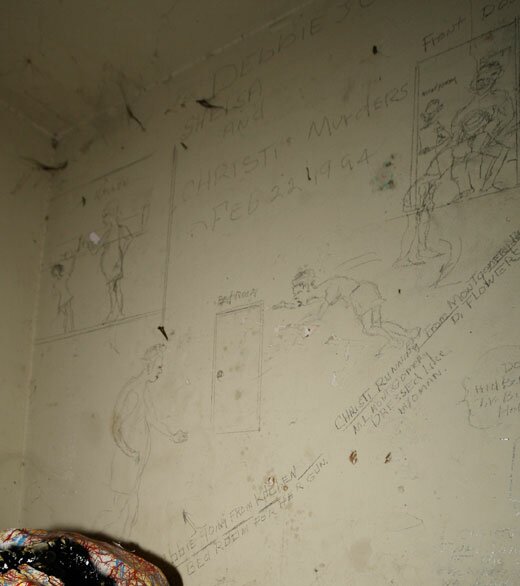
On the same day, the tallest angel in Heaven appeared to Seymour Perkins, revealing to him a tunnel that runs under his home, which is in fact the famous Underground Railroad. This tunnel connects his home to the Alamo and the Menger Hotel, and runs on down into Mexico. After receiving this prophecy (which I am recounting in only a very fragmentary and woefully incomplete way), Perkins founded the Debbie Jo Christi Museum, and Hanging Tough Ministries. Here is a painting of the tunnel running under the Perkins estate:
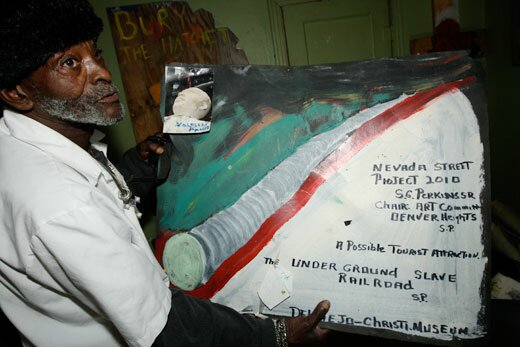
Here are a few shots inside the Debbie Jo Christi Museum:
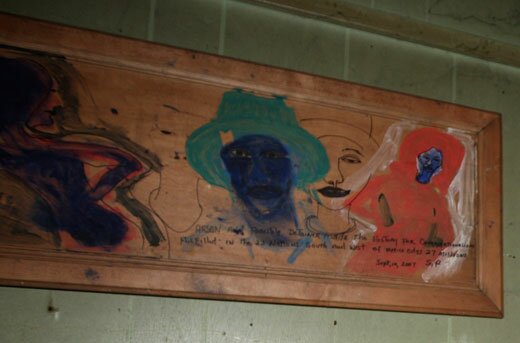
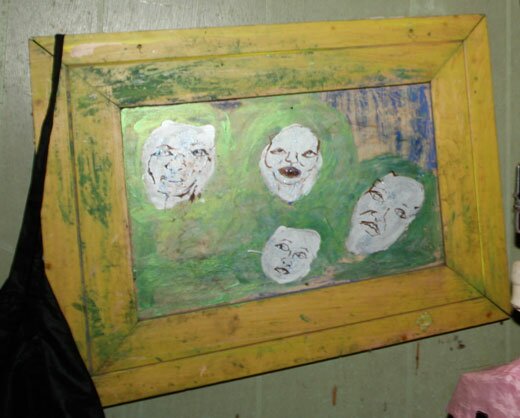
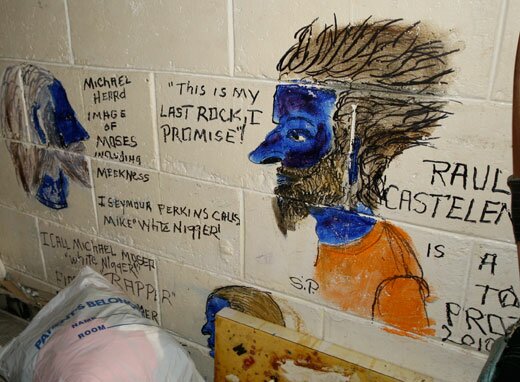
The Museum is located in a small building in the back of the house. But within the actual house, where Rev. Perkins delivers most of his sermons, there are a number of fascinating works. In his bedroom, the pieces below are painted on the wall. The first is a self-portrait of Rev. Perkins with his son:
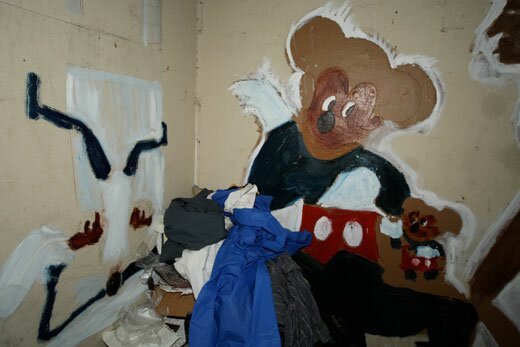
Next to this painting, is a larger work depicting one of his assistants, whose ass is stuck to his ass (i.e. he doesn’t know if he’s coming or going):
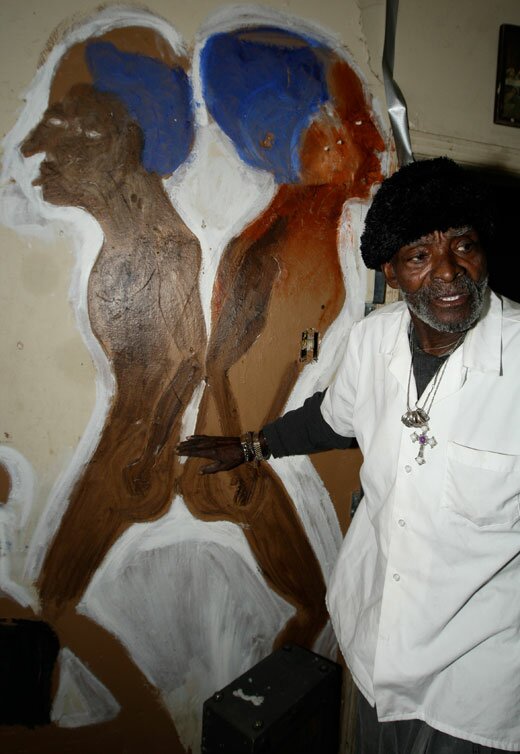
Below are a few details of one work painted on a window shade, depicting a man named Timothy Ringer, “the funkiest man in San Antonio”:
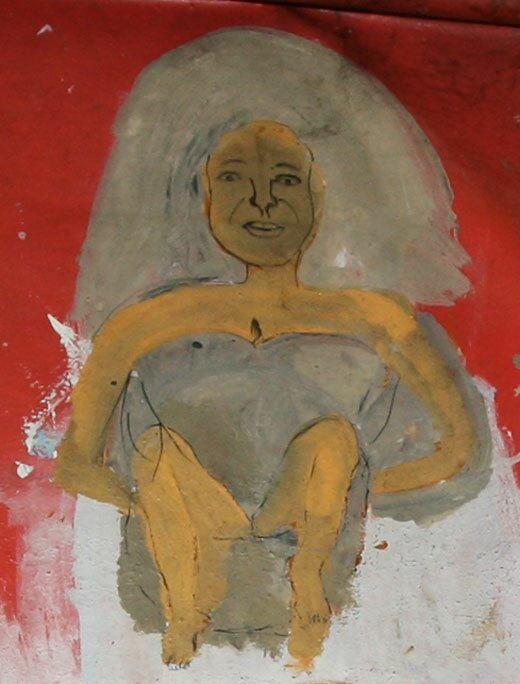

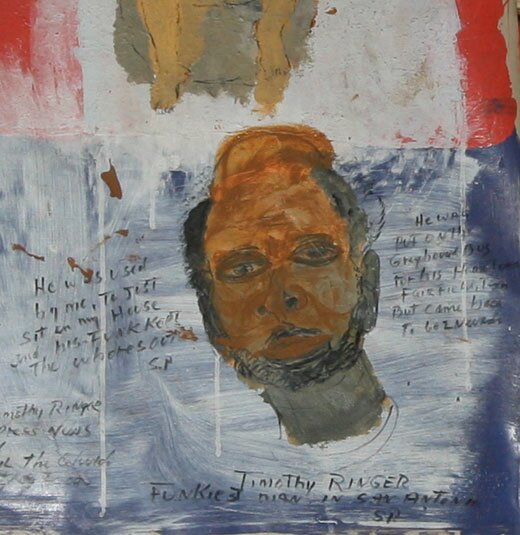
In addition to these works, dealing with himself, his family, and other meaningful people in his life, Perkins showed us a few pieces dealing with his relationship with God and History:
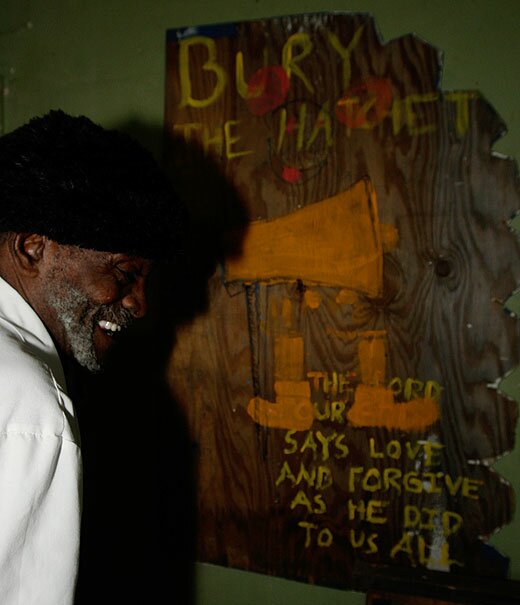
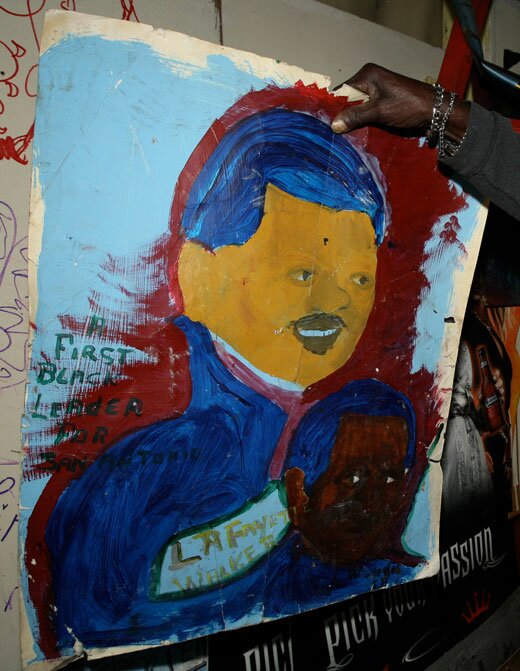
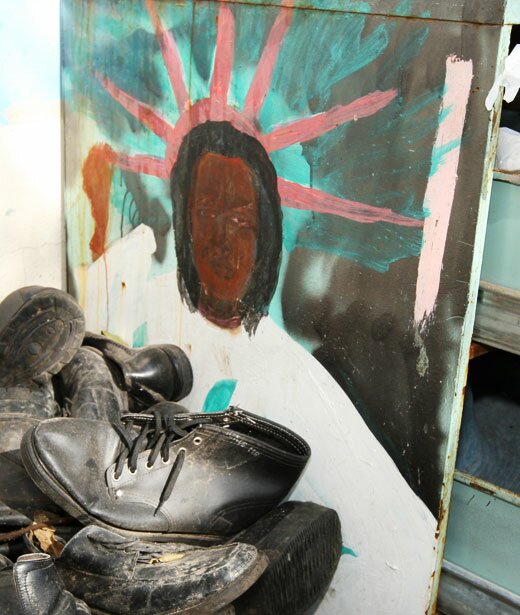
Now, this post isn’t intended to rally support around Rev. Seymour Perkins, or to say anything about his proper place in our community. I’ll leave that to his neighbors, his lawyers, and the city’s elected officials. But I did think it would be good for people to see what is inside his home — if it is destroyed in the coming months, this may sadly be one of the most complete documents of what it contained. To see more of his work, please visit the San Angel Folk Art gallery in the Blue Star arts complex.
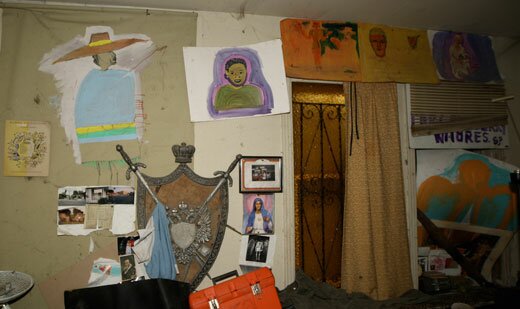
Posted by ben on 30 Jan 2008 | Tagged as: announcements

Forget about baby seals, now Big Oil is endangering the pristine ecosystem of the Spiral Jetty. MAN has more details. (NOTE: if you want to act on this, you have to do it this afternoon).
UPDATE: While I was having fun in Photoshop, Kriston Capps was actually doing research on where the proposed oil development would take place in relation to the Spiral Jetty. Please refer to his informative post on the drilling.
UPDATE 2: Yet more research by Michael Buitron reveals that the staging area will be about 50 miles from the Spiral Jetty. If the staging area is the only visible infrastructure, it’s hard to see how this would be a big deal. And anyway, I’m sure there are bigger concerns than the aesthetic pleasures of the Smithson Pilgrims. Not to be flippant (I hope to be one of those pilgrims myself someday), but when I’m making my list of concerns about energy sources, the impact on modern art isn’t in the #1 slot.
Posted by ben on 29 Jan 2008 | Tagged as: responses/reviews, tv
The American Prospect is hosting a dialogue on The Wire between some young political, cultural, and arts journalists. It’s much more probing than my recent post on the show, and if I hadn’t already watched through episode 7, I would think they are being a bit hard on it (they have only watched through episode 3). But the fact is, the show is descending into caricature, and with only three episodes to go, I don’t see much chance for redemption. I’ll explain more when the episodes actually air, but I think the problems with season 5 are summed up pretty well by the TAP crew (they just don’t realize yet how ridiculous it becomes).
One point that some of their commenters make is that since these are all journalists writing about the show, they find the newsroom dynamics to be lacking in subtlety, but those of us who haven’t worked in a newsroom find these interactions much more interesting. This sounds about right to me. It’s also worth pointing out that the “evil bosses” butting heads with the “virtuous editor” in the newsroom is not so different from interactions between McNulty and Rawls in the first season. McNulty wasn’t revealed in all his self-destructive, egomaniacal glory until pretty far into the first season. But I think we also need to face the fact that the show hasn’t been quite as subtle or complex as people make it out to be. This isn’t great literature, although it certainly raises the bar for TV dramas.
Finally, there’s been some discussion of “meta commentary” as The Wire becomes flatter and more caricatured. Is it possible that David Simon and Ed Burns are intentionally commenting on their own professional need to pull in viewers, much like the boss at the Sun who is obsessed with the “Dickensian aspect” of everything? Well, maybe. There is an episode called “The Dickensian Aspect” (episode 6); and, as Spencer Ackerman says, “consider that all our disbelief, objections and disappointments are voiced by Bunk. This is a big tell. Bunk stands in for the audience, thereby suggesting that we’re in for some serious misdirection.” I guess we’ll see. My feeling is that if this is true, after seven episodes The Wire’s writers have gone way too far down the rabbit hole of self-awareness and popped out on the other side: navel-gazing self-absorption. Alternatively, David Simon and Ed Burns aren’t quite as brilliant as everyone makes them out to be, and perhaps face real pressures from HBO that constricts their ability to effectively use the considerable talents they do have.
But I still can’t wait to see the final showdown between Omar and Marlo.
Posted by ben on 27 Jan 2008 | Tagged as: photography, vs.
The photographic archives surrounding two iconic war images have recently been discovered. In December of 2006, the Wall Street Journal tracked down the anonymous photographer of a Pulitzer-winning photograph of a 1979 execution in Iran. Now we learn that a suitcase full of negatives by Robert Capa of the Spanish Civil War have been discovered in Mexico City.
These two images have kept people searching for decades, trying to the find the stories behind the photos:

1979 Iranian Execution by Jahangir Razmi
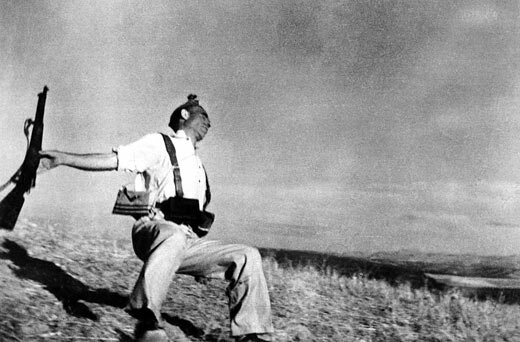
The Falling Soldier by Robert Capa (Spanish Civil War)
Posted by ben on 24 Jan 2008 | Tagged as: music, responses/reviews, sound art, video/film
Argentine artist Jorge Macchi has been all over South Texas lately — he was a resident at Artpace in 2005, he currently has a piece in the Triangle Project Space’s Standing on one foot, and the Blanton is showing Anatomy of Melancholy, his first “comprehensive U.S. exhibition,” through March 16.
As I wandered through the Blanton exhibit, I was reminded of the scene in The Breakfast Club when Allison (the “psycho” girl) puts on makeup and everyone realizes she’s a fox. Jorge Macchi has put in a lot of effort giving Fluxus a shave and a haircut, and what do you know, it fits very nicely into a standard gallery format. Macchi’s Caja de música, for instance, draws on the chance operations that ’60s experimentalists picked up from John Cage. Taking video of cars on a 5-lane highway, Macchi assigns a musical note to each lane, and as a car enters the frame the note corresponding to the lane it is in plays, creating a kind of randomized music box (you can watch this video on his site).
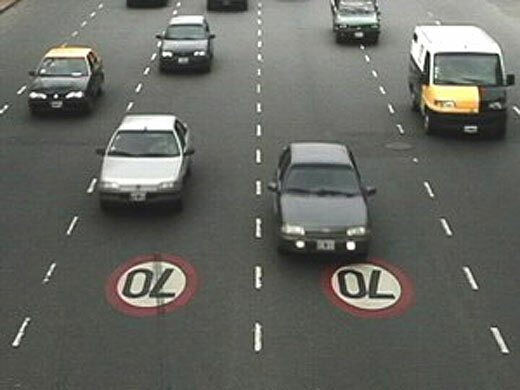
He’s also very fond of finding the edges of things, the demarcations, and focusing on those rather than the intended content of an appropriated work. For instance, at his Artpace residency, he took the final moments of several old movies and created video loops of the “The End” sequences. In an analogous move at the Blanton show, he cuts everything out of a map except the graveyards. These pieces draw our attention to the liminal moments, the insecurity of transition. Despite the summoning of these precarious situations, though, Macchi’s work feels very comfortable. He’s taken the ideas pioneered by Dada and Fluxus artists, art based on the awkward and the random, smoothed out the edges and made it feel very safe within the white walls of the museum.
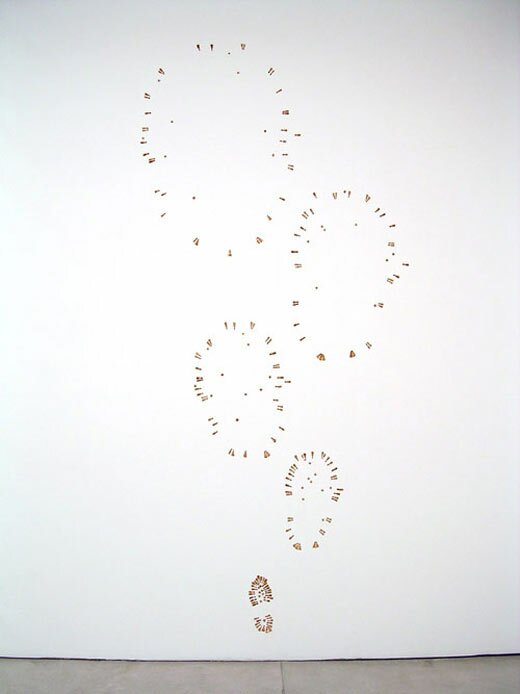
There are some very elegant pieces in the Blanton show, including Caja de música, and Fuegos de artificio, a piece in which footprints made of soil expand outward on the wall, progressively losing their form like ripples on a pond. This is a concise and beautiful statement about the impact we have on the world as we move through it, bringing with us the dirt of another place, which gradually loses the significance of having come from our shoes.
But I’m left wondering whether the ideas Macchi draws from are best expressed with the sort of finesse and refinement he brings to them. Maybe the chance operations of Arp, Cage, Maciunas and all the others are better left in a raw form. Maybe Allison was hot without the makeup.
Posted by justin on 20 Jan 2008 | Tagged as: adventure day, art paparazzi, celebrity sightings, performance art, possibilities, r.i.p.
exhibit a : Audio from Karen Mahaffy describing the execution.
exhibit b :

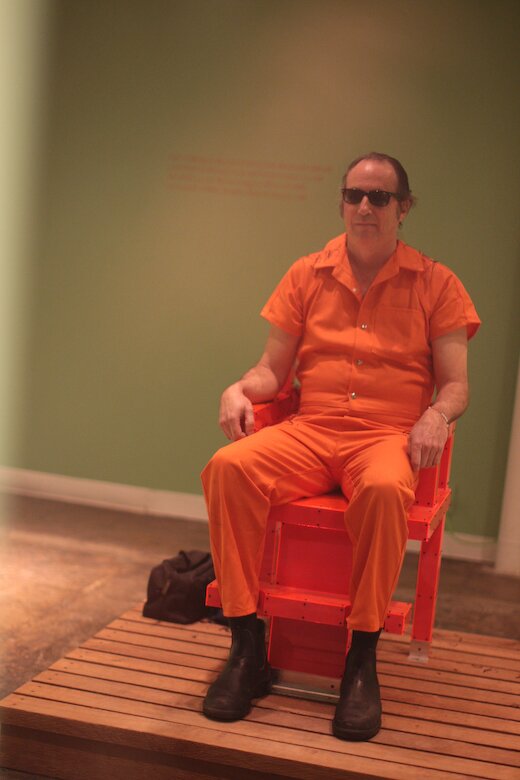

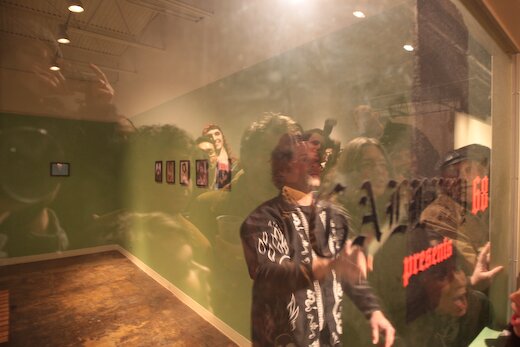
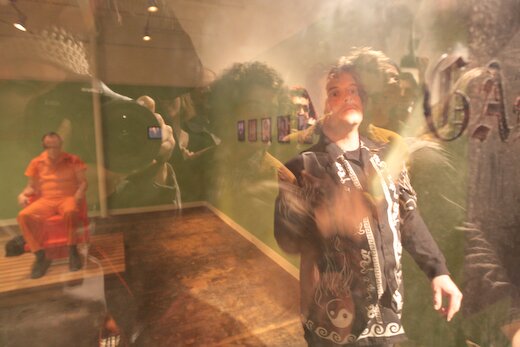
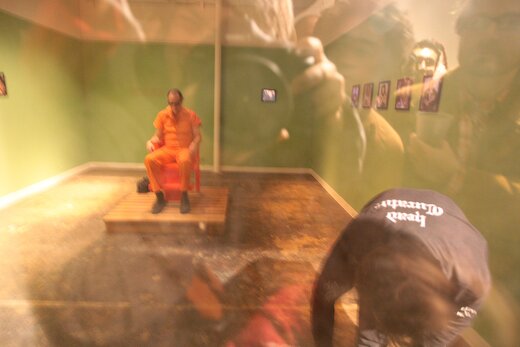
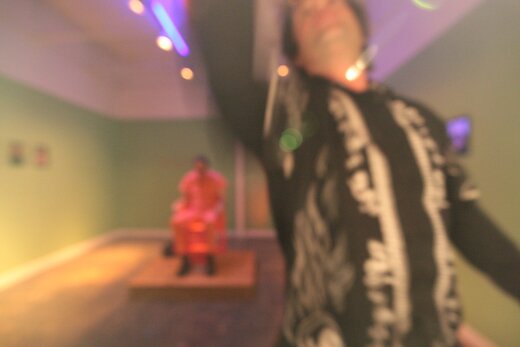
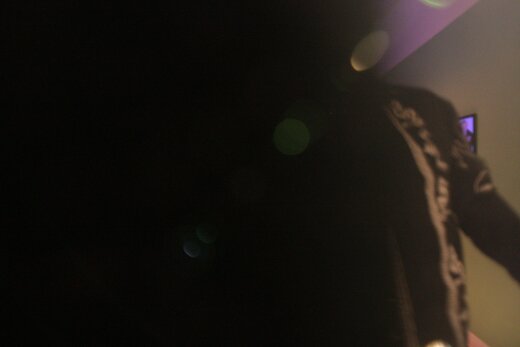

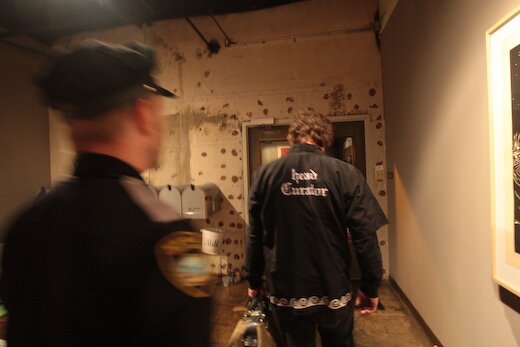
(photos copyright Justin Parr 2008)
INTRODUCING NEW EVIDENCE:
exhibit c : futureWorkerGirl reflects on artist as murderer, victim, pimp and ho.
Posted by ben on 18 Jan 2008 | Tagged as: responses/reviews, tv
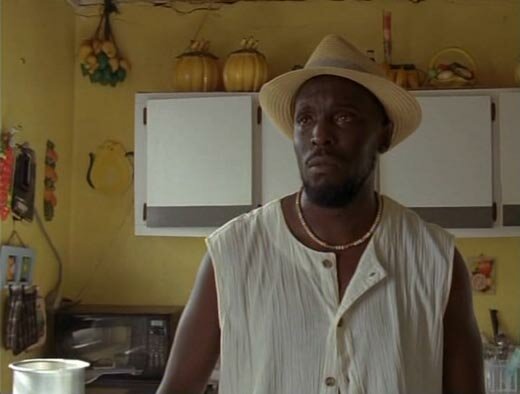
[The following post is about Episode 3, Season 5 of The Wire, and contains some pseudo-spoilers. Nothing very important is revealed, but you might want to hold off until you've seen the episode if you worry about things like that.]
This may be a bit hasty, but I can’t help thinking that The Wire is in mid-jump over the proverbial shark (and apparently at least one or two people agree with me). What I’m thinking of primarily is McNulty’s attempt to create a serial killer out of thin air in order to scare up some funds for the BPD. In Episode 2 I was willing to roll with it, since “the smartest guy in the room” is apparently spiraling into full-on alcoholism. But now they have the imminently reasonable Lester Freeman buying into the plot. And to top it all off, Omar surfaces in some unnamed tropical paradise, while Marlo heads down to the French Caribbean so he can see his money. I’m withholding judgment until Episode 4 makes it to the torrents, but I don’t like where any of this is going. Happily, the dynamic in the mayor’s office and in the newsroom at the Sun is pretty solid so far (although I’m a bit wary of this Jayson Blair-type business developing at the Sun).
Of course, my concern comes with some caveats (as if I hadn’t hedged my shark-jumping proclamation enough in the first paragraph). The Wire is one of the best shows I’ve ever seen, and the writers have done a terrific job of weaving together complex plot lines without straining the characters through four seasons. With McNulty in particular they’ve flipped the script on me in the past — through most of the first season I thought McNulty was a glorified McGarnagle, and that assessment turned out to be dead wrong. So here’s hoping The Wire’s writers have a plot twist up their sleeves that elegantly resolves all my worries and cements the show’s reputation as “best ever.” But if they don’t, I think Episode 3 will be seen as the moment everything started falling apart.
Posted by ben on 17 Jan 2008 | Tagged as: in yo face, tattoo, vs.
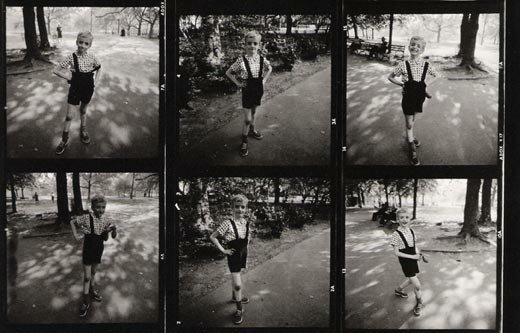
Contact Sheet of Child with a Toy Hand Grenade in Central Park by Diane Arbus, 1962 (Detail — full image here)
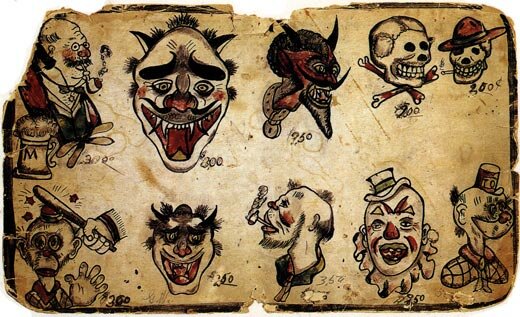
Tattoo flash sheet by Gus Wagner, ca. 1900 (via )
Posted by ben on 16 Jan 2008 | Tagged as: in yo face, vs.
Posted by ben on 11 Jan 2008 | Tagged as: art + bikes, design, in yo face, performance art, silliness
As many of you know, San Antonio sculptor / performer Jimmy Kuehnle has been in Japan since August working on a Fulbright project. He recently posted photos of his first two exhibits, at the Kyoto Museum (Artjam 2007) and the Aichi Geidai Gallery in the Aichi Prefectural University of Fine Arts and Music. Continuing a body of work he started in San Antonio, Kuehnle fabricated huge, inflatable sculptures, which also served as interactive / performance pieces.
Mr. Bubble Head, which Kuehnle made for Artjam, is a huge orange inflatable sculpture with ropes criss-crossing inside. Kuehnle spend much of the opening inside the sculpture tugging on the ropes as people walked by, creating an impression of organic response to the viewers’ presence. Museum visitors were also allowed inside the sculpture at various points, turning it into an interactive sculpture.
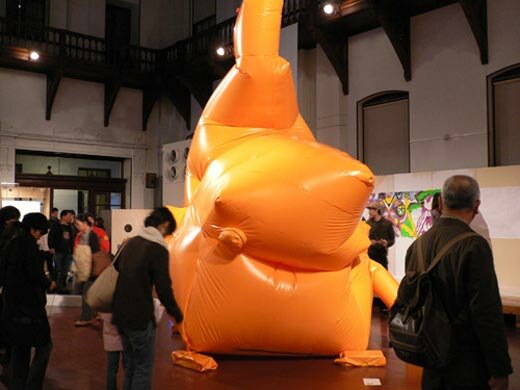
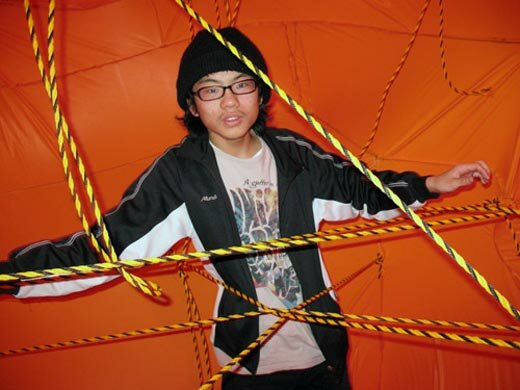
His piece at the Aichi Geidai Gallery, called Big Blob, was another inflatable sculpture made of the same orange material. This piece, however, was a suit which Kuehnle could walk around in “like a large leviathan.” After his performance in this enormous suit, Kuehnle invited audience members to try it on — but it seems a bit more unwieldy than those ridiculous sumo suits.
